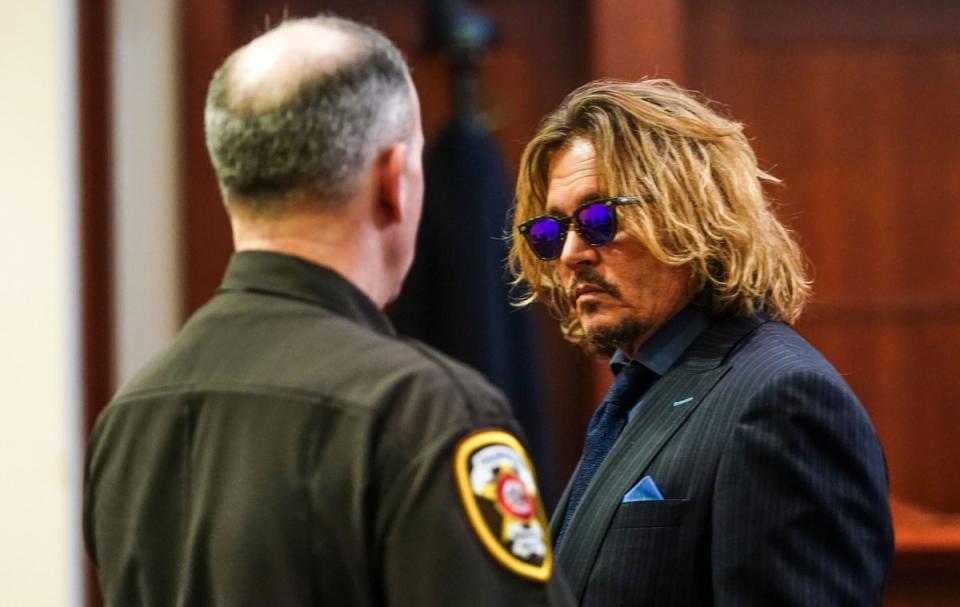Depp v Heard review: How the Hollywood court case exposed the ugly side of social media
It is said, by historians of language use, that the phrase “he-said, she-said” was popularised in 1991 when American lawyer Anita Hill testified against Clarence Thomas, who had been nominated to the Supreme Court, claiming he sexually assaulted her. That may have brought the flippant phrase into common usage, but some form of it has doubtless been around since cavefolk started using pronouns. And nowhere in recent years has the concept of this tit-for-tat battle of opposing perspectives been rendered more starkly than in the defamation case waged by Hollywood actor Johnny Depp against his ex-wife, Amber Heard, the subject of a new three-part Channel 4 series, Depp v Heard.
Emma Cooper’s documentary purports to be, through the magic of editing, the first time that Depp and Heard’s testimony has been presented side-by-side (in reality, they testified two weeks apart). But more strikingly, this collage is presented alongside snapshots of the public show trial. As social media began to turn against Heard, the documentary illustrates the pernicious influence of civilian journalists – from TikTok to podcasts – in picking over the bones of this case, which was broadcast live from a Virginia courtroom. “This has moved away from a news story or a lawsuit,” observes Dellara Gorjian, a vaguely legally qualified TikToker, “and it’s transformed into a cultural moment.”
A cultural moment, indeed, albeit not an especially edifying one. Coverage of the case, at the time, was relentless, due to the choice of the Depp encampment to wage an air war against Heard, via courtroom TV. So, what is there to add to the live-streams, the front pages, the endless tweets? There is some sense to the reordering of the narrative to juxtapose their impressions, which makes transparent the dissonance of certain pieces of evidence. This is a dramatic construct that’s been used in everything from Rashomon to Gone Girl and is the nub of what made the Depp v Heard case so compelling. But the idea that braiding their narratives offers special insight is rendered moot by the extent to which the same technique was relentlessly applied by amateur sleuths during the case. The only difference here is that instead of TikToks lasting a few seconds, we’re subjected to three 45-minute episodes, broadcast on terrestrial TV.
More convincingly original in Depp v Heard are the integration of social media and news video. “I’m not a legal scholar, I’m not a lawyer,” disclaims DARTHN3WS, a YouTuber in a Deadpool mask, as he provides reams of live legal commentary. The project captures the level of hysteria, and the extent to which Depp dominated the PR battle (“There’s no Amber Heard fans,” observes a bystander on the opening day of the trial, “nobody’s there for Amber”). Eschewing talking heads or voiceover exposition gives the pretence of dispassion, but it also strips the show of context. There is no real scrutiny of the social or political trends that resulted in the anti-Heard popular consensus. There is also – strangely, for a show airing on UK television – no reference to the fact that Depp had already lost a defamation case, against The Sun newspaper, in British courts. And so, we end up with two hours relitigating a piece of litigation; a Match of the Day highlights package, where the game is two beautiful strangers’ lives.

“This was a humiliation ritual intended to put women in their place,” observes one TikToker. He-said, she-said stories – from competing narratives in the royal family to Jason Sudeikis serving Olivia Wilde papers on-stage at CinemaCon – are an addiction of modern media. There is, however, a clue in the name: the male voice is prioritised. It’s hard to come away from Depp v Heard with any sensation other than queasiness. The American courtroom system turned these domestic and sexual assault allegations into a Punch and Judy show for the masses. That was bad enough, in the moment, but the protraction of this damaging psychodrama for the purposes of “entertainment” ought to worry us just as much.


